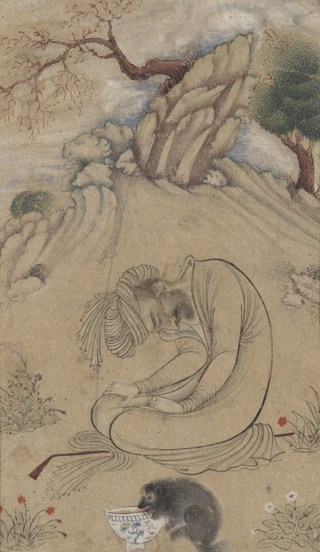Ascetic in Meditation

Ascetic in Meditation, Mu’in Musavvir (Persian, ca. 1610–1693), 17th century, Iran
Accession no. 2001.138.7
Yale University Art Gallery
Ascetic in Meditation is a single work of ink and opaque watercolor on paper, dated to seventeenth-century Iran. The Safavid period (1501–1722) was characterized by devout religiosity, economic prosperity, and artistic innovation. Single paintings like Musavvir’s Ascetic in Meditation, often placed in albums and shared at social gatherings, gained popularity in the seventeenth century. Musavvir was trained under the renowned Reżā ʿAbbāsi, who popularized this style of miniature paintings, particularly of individuals amidst landscapes.
The work depicts a pious man, suggested to be a Muslim ascetic, meditating amidst a sparse landscape. He kneels on the ground, bent over, with his eyes closed and head bowed. Below him, a rodent drinks from what appears to be a rare, luxurious porcelain ceramic from China. His disinterest in this material good emphasizes his focus on his own spiritual journey. Color is used intentionally and sparingly, with the colorless figure, composed of swooping calligraphic lines, blending into the landscape. The ascetic’s meditation amidst a natural setting, devoid of the grandeur often associated with royal commissions, suggests a deliberate choice by Musavvir to highlight the individual’s spiritual journey over religious or political narratives.
Sources:
Farhad, Massumeh. “Safavid single page painting, 1629-1666.” PhD diss. Harvard University, 1987.
Roxburgh, David J. “Persian Drawing, c. 1400-1450: Materials and Creative Procedures.” Muqarnas 19 (2002): 44-77.
